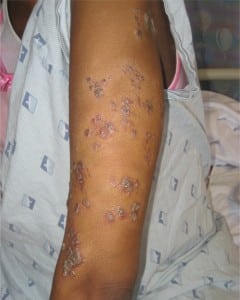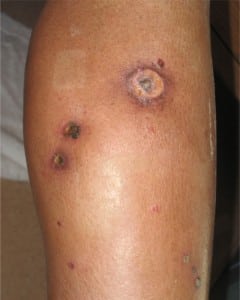| Author | Affiliation |
|---|---|
| Andrew C. Miller, MD | State University of New York Downstate Medical Center and Kings County Hospital Center, Departments of Emergency Medicine and Internal Medicine, Brooklyn, NY |
| Rashid M. Rashid, MD, PhD | MD Anderson Cancer Center, Department of Dermatology, University of Texas. Houston, TX |
| Elamin M. Elamin, MD, MSc | University of Florida, Departments of Pulmonary, Critical Care, and Anesthesiology, Gainsville, FL |
A 34-year-old African American woman presented with shortness-of-breath, wheezing, pedal edema, and a rash. On examination she had reddish-purple indurated plaques and nodules on the nasal rim and cheeks, and raised plaques on the trunk and extremities (Figures 1 and and2).2). Jugular venous distension, diffuse wheezing, rales, and bilateral pitting pedal edema were present. Her chest x-ray and CT scan demonstrated bilateral hilar lymphadenopathy. A 2-D echo revealed a 10% ejection fraction. Serum was ANA-negative with elevated angiotensin-converting enzyme levels and lymphocytopenia. Cutaneous biopsies showed non-caseating granulomas. The attending physician diagnosed disseminated sarcoidosis and initiated systemic steroid treatment. The patient was to have an automatic implantable cardioverter defibrillator (ICD) placed due to advanced cardiomyopathy and, as per protocol, underwent routine cardiac catheterization one day prior. The patient died post-catheterization from unstable ventricular tachycardia.


This patient’s skin findings are characteristic of plaque sarcoidosis with nasal lupus pernio. This chronic granulomatous disorder is characterized by activated T-lymphocytes and macrophages and may involve any organ system. Cutaneous lesions were the first recognized manifestations of sarcoidosis.1 The ACCESS study characterized sarcoidosis in 736 patients in the U.S.2 Sarcoid-specific cutaneous lesions were observed in 15.9% of all sarcoid patients.2 Plaque sarcoid heralds long-standing disease, and lupus pernio is highly predictive of upper airway involvement. The ACCESS study criteria for diagnosing cardiac involvement rely on the presence of cardiomyopathy or electrocardiographic or scintigraphic abnormalities in patients with known sarcoidosis.3 Conversely, the Japanese Ministry of Health and Welfare criteria take into account symptoms, electrocardiographic, echocardiographic, and scintigraphic findings.3 Corticosteroids remain the cornerstone of treatment.1 Current guidelines for ICD implantation are the same as for those with other nonischemic cardiomyopathies.3 Emergency physicians must remember that “all that wheezes is not asthma.” Multi-system disorders such as sarcoidosis must be considered in patients with shortness-of-breath, rash, and signs of heart failure.
Footnotes
Supervising Section Editor: Eric R. Snoey, MD
Submission history: Submitted September 4, 2008; Revision Received September 23, 2008; Accepted November 28, 2008
Full text available through open access at http://escholarship.org/uc/uciem_westjem
Address for Correspondence: Andrew C. Miller, MD, Department of Emergency Medicine, 450 Clarkson Avenue, Box 1228, Brooklyn, NY 11203–2098. Email: andrewcmiller@optonline.net
Email: taqwa1@gmail.com
Conflicts of Interest: By the WestJEM article submission agreement, all authors are required to disclose all affiliations, funding sources, and financial or management relationships that could be perceived as potential sources of bias. The authors disclosed none.
REFERENCES
1. Rose AS, Tielker MA, Knox KS. Hepatic, Ocular, and Cutaneous Sarcoidosis. Clin Chest Med.2008;29:509–524. [PubMed]
2. Baughman RP, Teirstein AS, Judson MA, et al. Clinical characteristics of patients in a case–control study of sarcoidosis Am J Respir Crit Care Med 2001. 164(10 Pt 1):1885–9.9. [PubMed]
3. Lubitz SA, Goldbarg SH, Mehta D. Sudden Cardiac Death in Infiltrative Cardiomyopathies: Sarcoidosis, Scleroderma, Amyloidosis, Hemachromatosis. Prog Cardiovasc Dis. 2008;51:58–73.[PubMed]


